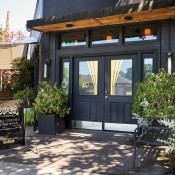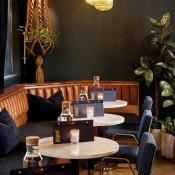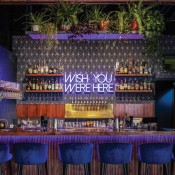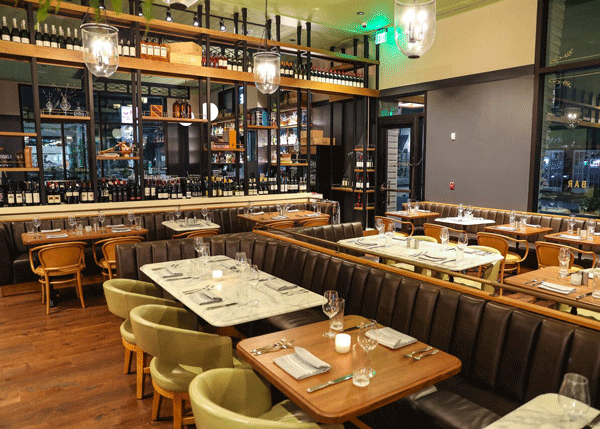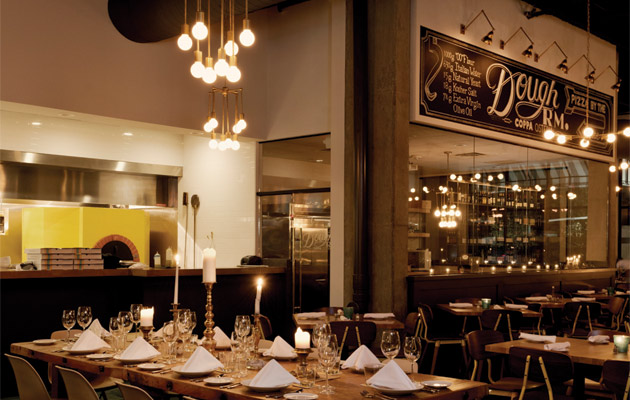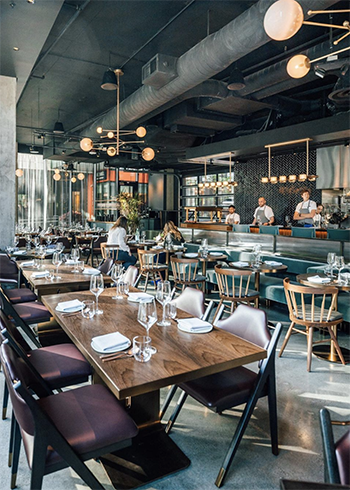If you’ve not heard, listening bars are having a moment. They’re based on the Japanese kissa, which is a cafe specializing in playing and appreciating jazz.
The most important aspect of a listening bar is a great sound system paired with proper acoustics, but there are infinite variations on the theme. Some American operators are putting more emphasis on music and listening than others. They’re all putting their own spin on what makes for a great listening bar.
Here we look at three and delve into what makes them tick, from both a sound and a design perspective.
Shibuya
Seattle
Shibuya is that rare thing: The strictest of listening bars.
Guests enter this venue into the bar and lounge area, but then head to the back for the listening room, which is known as the Hi-Fi room.
This room is serious business, and it’s open only for guests who have signed up for that night’s vinyl or for private events. Food and drink are not allowed. Guests are encouraged to take their shoes off and make themselves at home but not to talk. “We wanted to shift people’s sense of awareness of what they were stepping into,” says Quentin Ertel, co-owner and co-founder of Shibuya and owner and founder of Studio Q design. “You’re in a room full of strangers checking out people’s socks and ready for something new.”
Ertel has been passionate about music his whole life. He opened Shibuya with his business partner in September 2023 to introduce customers to serious listening. In the planning stages of Shibuya, he introduced acoustic panels along the walls “but it killed the room — the look, feel and sound,” he says. “It deadened the sound.”
So, Ertel took them down and found that with the lounge chairs, armchairs, booths, rugs and human bodies, “it really quieted everything down. The sound is even different based on how many people are in the room."
But a lot of this comes down to a sound system that’s second to none. Ertel and his partner were adamant that they wanted vintage Klipschorn speakers and, after looking all over for them, found a rare set nearby. “We knew we had to have them, even though they were really expensive,” he says.
The speakers are complemented by two modern and well-known speakers, ATC SCM50s. In the lounge there are two other sets of speakers, from Café Sound and JBL Classic L100s.
While sound is important, design was critical, too. Both rooms feature cedar wood, which is very warm but also helps with acoustics. “Wood is reverberant, especially when it comes to bass,” says Ertel. The wood was already in the space — this was formerly a nightclub — when he and his partner took it over, and they wanted to be as thoughtful with the design as performers are about making records.
With that in mind, they sourced a lot of the furniture from close to the venue, often from local craftspeople, though the rugs came from Afghanistan. The booths and chandeliers came from the nearby Benaroya Hall, home of the Seattle Symphony. “Every detail is considered,” Ertel says.
There are also a lot of textures, as well as a lot of color, patterns and shapes in the fabrics. “I wanted to give people a sense of relaxation and comfort. The tactile part is very important,” Ertel explains.
And Ertel felt they could branch out with the fabrics because the wood is all the same tone, providing a cohesive background, he says. “We wanted to use color to make things sing.”

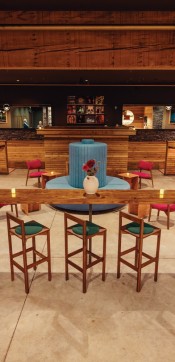
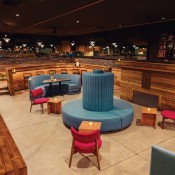


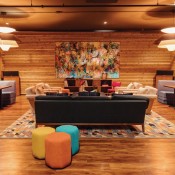
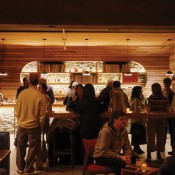
Eavesdrop
New York City
Eavesdrop was created with the idea that “good sound is a core part of the hospitality experience,” according to Danny Keith Taylor, part owner and designer.
This venue has a bar running down one side and the record player and speakers are in the lounge area, along with a DJ booth. “That’s our concept of a listening room — more the listening to each other and listening to music together and focusing on the communal aspect,” Taylor says.
Creating a community space was the goal of Eavesdrop. Even though in a traditional kissa there’s a sort of reverence for the music that’s playing, Taylor didn’t want that to happen.
Taylor did want a top-notch and identifiable sound system at Eavesdrop. The main speakers by the DJ booth are modified Danley Sound Labs SH60s with four subwoofers, two visible and two tucked away behind grates. In the bar are custom-designed House Under Magic speakers. “The sound is never supposed to be dominant but it’s a bit louder in the back than at the bar; there’s more emphasis on it,” he points out.
For acoustics, Taylor says, “there are two paths, either absorption, when you want to stop the sound in its tracks, or diffusion, where the sound hits something and scatters.” And while Taylor did include some sound-absorbing panels in
Eavesdrop, mostly on the ceiling, he mostly opted for diffusion. A diffusion wall has multiple mirrors at varying heights that bounces the sound back into the room and also increases the perception of the size of the room, which is a cozy 1,000 square feet.
A rear booth, near the record player, works to trap the bass waves as they travel around the room. The entire soffit is filled with acoustic material and Taylor deliberately created this little space with a dropped ceiling as a cozy nook for up to five people to sit in.
Design-wise, Eavesdrop is filled with Baltic birch wood, most of it inherited from the bar that was in the space before. Taylor and his partner poured the white concrete bar themselves, mixed in some local stones and then sanded it down to give it a terrazzo look.
Rafters arch up the walls and across the ceiling, and Taylor hoped they’d take on the staggered geometric feel of Japanese pathways. And from a practical standpoint, he says, they subdivide the back bar, creating bays for different types of liquor. Lights on the rafters emphasize the curves as an architectural element.
Eavesdrop doesn’t encourage silence for listening to the music. But to keep the hubbub of conversation under control, reservations are needed and there are just 38 seats.






Decibel
Milwaukie, Ore.
The goal of Sarah Pletka, co-owner of Decibel and its designer, was to create an elevated yet unpretentious space where everyone feels at home and can enjoy music.
“We wanted it to feel like an oversized living room,” Pletka says.
A brown leather-look banquette lines one wall. It features two- and four-top tables and on-trend navy and gold chairs to complete the polished look. A living room-style lounge sits in the middle with soft, cozy seating, tables and rugs.
Pletka used color to make the space feel cozy, with rich tones like dark blues and golds found throughout.
The bar in Decibel extends the aesthetic. The back bar is covered in an art deco-inspired wallpaper. A walnut backsplash — sourced from Pletka’s grandfather — frames the beer taps with handles made from repurposed vacuum tubes (and traditionally used in amplifiers — a clever nod to the high-end audio theme). The same walnut wood is seen in the bar front, the coffee tables and the record player cabinet.
A custom neon-look light proclaims “Wish You Were Here” above the bar. And it’s not just a playful shoutout to Pink Floyd: the light’s color can change to match the night’s vibe. Hanging and other assorted plants near the bar add softness and a biophilic element while contribution to the overall residential scale.
The bar top was salvaged from a bowling alley and Pletka had it sanded and finished. “We ran into challenges we didn’t expect — bowling lanes are pretty flexible so we had to run 2-foot steel rods through the bar every foot to keep it rigid,” she says.
Pletka had only a very small budget for Decibel and just $1,000 for the lighting. She found green glass pendants to hang over the tables to create intimacy under the vast ceiling and also to draw customers’ eyes up to the beautiful ceiling trusses above. They’re dimmed at night because green-tinted light is not necessarily the most flattering.
The record player and record storage cabinet is at one end of the 1,000-square-foot space and the cabinet that it’s all housed in was designed to look residential. Sound-wise, Decibel has top-of-the-line speakers: RCA MI-9462s, Altec 1505s, and JBL 077 tweeters. The cabinet was designed for the vintage RCA speakers.
The speakers are bigger than the space needs and they don’t reach their potential in the small space, according to Pletka. But having so much upholstered furniture, banquettes, thick velvet curtains and rugs was intentional, Pletka says. “We didn’t want to hang sound panels from the ceiling because we have beautiful old trusses,” so the fabric and furniture absorb the sound.
Music is more of a background element at Decibel, and a nod to the musical background of Pletka’s family, intended to highlight the energy and mood in the space.


